
Châtenay-Malabry (FR - 92290), February 12, 2024
EFITA newsletter / 1088 - European Federation for Information Technology in Agriculture, Food and the Environment
The informatique-agricole.org site offers you the possibility of subscribing the RSS feeds of its two newsletters
See RSS feeds to implement to ensure that you continue to receive this newsletter
To unsubscribe this newsletter, please contact me directely: guy.waksman(a)laposte.net if this link Unsubscribe does not work.

To correspond with me (GW), please use this address: guy.waksman(a)laposte.net
To subscribe the efita newsletter (please ask your friends and colleagues to test this link)
Efita Newsletters subscription
How Europe’s wine regions are coping with climate change, by Vitisphere, February 09, 2024
The climate around the Mediterranean rim is changing. On January 30 at the Institut Agro in Montpellier, engineering student Quentin Gerona invited winegrowers to rethink “their vision of the ecosystem and their place in it”. Gerona screened the documentary ‘Vignes sur le Fil’ (or vines down to the wire) which he co-produced with Emma Crouzet and Isaure Sellier, a member of the RaidWine association, during a five-month tour of Spain, Portugal, Italy and Greece.
See vitisphere.com
A Rare Magic Bow and String Stunt, Birdsong Played by Instrument Passes Fake Imitation for Genuine (fake music?)
See video
Before computers / Avant l'informatique : Deering 10/20 tractor and Mac Cormick IH harvester / Tracteur Deering 10/20 et moissonneuse Mac Cormick IH
|
12/02/2024
|
 |
Weekly newsletters about ICT in Agriculture in English and French
Both newsletters have around 5000 subscribers.
>>> Last weekly EFITA Newsletters in English (created in 1999)
Efita
Newsletters
>>> Last weekly AFIA Newsletters in French (created more than
20 years ago in 1997) Afia
Newsletters
>>> Statistics
for the latest efita newsletter
>>> Latest
issue of the afia newsletter
FutureFarming.com
> 10.000 ha in 6 months, a robot that has proved its worth!
The SwarmBot, designed entirely in Australia by Queensland farmers, has
successfully established itself in the modern farming landscape.
> Field robots: Yanmar unveils electric concept e-X1 field robot for
fossil-free agriculture
Yanmar AG has unveiled its new concept, the e-X1, an electric compact
agricultural robot designed to lead the way in emission-free farming.
> Market information: Small Robot Company proceeds into liquidation
UK's Small Robot Company proceeds into liquidation. According to SRC they
had a signed Term Sheet, but unfortunately the investment did not land
before the runway ended.
> Articulated tractors: Australian Acremaster articulated tractors
are making a comeback
The Australian brand Acremaster, which built articulated tractors from
the mid-1970s to the mid-1980s, is returning this year with a new tractor
series.
> Market information: Saga Robotics secures $ 11,5 million in
growth capital, expansion Thorvald 3
Technology company Saga Robotics has successfully raised $11,5 million
in growth capital through an equity transaction.
> Market information: Homburg Holland to sell Swedish Ekobot in the
Netherlands
Homburg Holland will sell the Swedish weeding robot Ekobot in the Netherlands.
> Fertilizers: ‘Tow and Fert’ technology breaking down fertilizer and
costs
More crop and vegetable farmers are switching on to the idea of foliar
fertiliser applications in a bid to become more efficient and save money.
> Fertilizers: SelectShot... set it, forget it, and save on fertilizer
while seeding
CapstanAG’s SelectShot allows farmers to place a shot of fertilizer precisely
before, on, or after seeds, as they are planted in the soil.
> Loaders: Bobcat showcases new version of autonomous RogueX skid-steer
loader
Doosan Bobcat is presenting a second version of an autonomous RogueX skid-steer
loader at the Consumer Electronics Show (CES) in Las Vegas, USA.
> Digital orchards: capturing pruning expertise in digital twins
The OnePlanet Research Center is focusing on preserving the knowledge
of expert growers.
> ‘Costs precision spraying in soybean and maize crops 2.3 times lower
than conventional’
Researchers in Brazil found that the costs of pesticide application via
a real-time precision spraying system in soybean and maize crops were
2.3 times lower than pesticide application with a conventional sprayer.
> Fertilizers: Farmers making fertilizer: an update on FuelPositive
technology
Canadian technology enables crop farmers to manufacture their own fertilizer
from air and water, with renewable energy where possible.
> Market information: Väderstad initiates collaboration with Ekobot
Swedish manufacturer Vӓderstad is entering into a partnership with
Ekobot AB, a Swedish manufacturer of automatic agricultural robots.
> Exhibitions: French SIMA 2024 cancelled due to agricultural crisis
ExpoSima, the organizer of the French trade fair SIMA, has decided to
cancel the organization of the fair in 2024.
> Market information: Small Robot Company proceeds into liquidation
UK's Small Robot company proceeds into liquidation. According to SRC they
had a signed Term Sheet, but the investment did not land before the runway
ended.
> Articulated tractors: Australian Acremaster articulated tractors
are making a comeback
The Australian brand Acremaster, which built articulated tractors from
the mid-1970s to the mid-1980s, is returning this year with a new tractor
series.
> Field robots: Yanmar unveils electric concept e-X1 field robot for
fossil-free agriculture
Yanmar AG has unveiled its new concept, the e-X1, an electric compact
agricultural robot designed to lead the way in emission-free farming.
> Field robots: 10.000 ha in 6 months, a robot that has proved its
worth!
The SwarmBot, designed entirely in Australia by Queensland farmers, has
successfully established itself in the modern farming landscape.
>Fertilizer: SelectShot: set it, forget it, and save on fertilizer
while seeding
CapstanAG’s SelectShot allows farmers to place a shot of fertilizer precisely
before, on, or after seeds, as they are planted in the soil.
See futurefarming.com
Troupeau au bord de l’eau, 1904, par Léon-Augustin Lhermitte (1844-1925)
|
03 - 12/02//2024 |
 |
Repos pendant la moisson, par Léon-Augustin Lhermitte (1844-1925)
|
02 - 12/02//2024 |
 |
Global High Tech Initiative
Global Ag Tech Initiative
> Infusing Ag Tech Into the Future
Corteva's Brian Lutz discussed the cross-industry synergies that will
shape the future of ag tech at the recent VISION Conference.
> Marketing in Ag Tech: How to Effectively Reach Your Audience
A recent podcast sheds light on the complexities of marketing in the ag
tech sector and offers practical insights for driving adoption.
> How GeoPard and Indigo Ag Are Advancing Sustainable and Regenerative
Agriculture
GeoPard’s expertise in geospatial analytics is key in cleaning, normalizing,
and analyzing farm data from Indigo Ag’s trial fields.
> VISION Conference Wraps With Optimism for Ag Tech
The second day of the VISION Conference carried just as much energy as
the first and attendees were just as engaged.
> Revolutionizing Ag Tech Adoption
Increasing adoption of new technology was a recurring theme at the recent
VISION Conference in Glendale, AZ.
> Establishing a Common Language for Data in Agriculture
The new partnership between Proagrica CDMS and Lexagri represents a concerted
effort to drive forward a common language for data.
> Marketing in Ag Tech: Best Practices and Tips for Reaching Your Audience
AquaSpy's Kathleen Glass discusses the unique challenges of marketing
in the ag tech space in the first episode of the Ground Breaking podcast.
> 5 Tech Drivers Behind Key Trends in Food and Agriculture in 2024
Purdue's Dr. Allan Gray explores key trends and their associated technologies,
signaling a transformative era in this sector.
> Establishing a Common Language for Data in Agriculture
The new partnership between Proagrica CDMS and Lexagri represents a concerted
effort to drive forward a common language for data.
> Carbon Capture Technologies: Optimizing CO2 Utilization to Reduce
Emissions in Agriculture
Recent innovations are driving the scope and capability of carbon sequestration
in agriculture.
> Agricultural Robotics Market Poised To Kick Growth Into High Gear
The escalating cost of labor continues to push farm automation to new
levels. Report expects an $86.5 billion enterprise by 2033.
> 2024 VISION Conference: Ag Tech Adoption, AI and Data Usage Among
Key Topics Discussed on Day One
Day one of the 7th VISION Conference was high energy and filled with as
much insight into the ag tech industry as attendees could soak up.
See globalagtechinitiative.com
Bords de Marne près d'Alfort, par Léon-Augustin Lhermitte (1844-1925)
|
03 - 12/02//2024 |
 |
La famille, 1908, par Léon-Augustin Lhermitte (1844-1925)
|
04 - 12/02//2024 |
 |
Costs precision spraying in soybean and maize crops 2.3 times lower
than conventional
See
futurefarming.com
John Deere, Corteva Partner to Deliver Customized Agronomic Solutions
to Farmers
For years, farmers have had to navigate a complex landscape of digital
tools to harness the power of their on-farm data. Corteva Agriscience
and John Deere have announced a partnership to make it easier for farmers
to access Corteva’s industry-leading agronomic recommendations through
the John Deere Operations Center.
…/…
See
globalagtechinitiative.com
‘Low ROI’ still the top reason farmers won’t engage in carbon projects,
says Purdue survey. By Jennifer Marston
Low adoption is likely due to the economic and logistical burdens placed
on farmers in order to participate in carbon sequestration programs.
- Nearly 10% of farm producers have engaged in talks about carbon capture,
says the latest Purdue University/CME Group Ag Economy Barometer report.
- The percentage of producers discussing carbon contracts in 2024 is consistent
with survey responses from previous years.
- Low adoption is likely due to the economic and logistical burdens placed
on farmers in order to participate in carbon sequestration programs.
- The Ag Economy Barometer calculates data from US agricultural producers
that participate in a survey each month.
See
agfundernews.com
Innovating the ‘picks and shovels’ of the greenhouse: Why AgFunder
invested in robotics startup Neatleaf, by Tom Shields
Neatleaf has built a straightforward ag robotics platform focused on plant-health
and yield. Customers say they can’t work without it.
More often than not, the simplest innovations are the best.
When California-based Neatleaf reached out to AgFunder a couple years
ago, we were struck by the company’s no-nonsense approach to autonomous
ag robotics systems, which it is developing for greenhouse environments.
Such simplicity makes for a much-needed shift for indoor ag, a sector
that’s been plagued by overpromising, underdelivering, and a lot of expensive,
complex technologies. Rather than focusing on yield increases or plant
health, many indoor ag players to date have touted the benefits of 100%
unique systems or automated for the sake of automation.
The straightforwardness of Neatleaf’s product combined with the company’s
tight focus on improving plant health and yield is a welcome change.
Neatleaf’s flagship product, a fully autonomous robotic platform called
the Spyder, scans crops in the greenhouse and generates millions of data
points on plant health and growth. The system can then analyze that data
and turn it into insights on which the cultivation team can take action.
To accomplish this, Neatleaf has a fairly simple approach: it uses a cable
system, similar to the cameras you see at NFL games, to cover the entire
greenhouse with one set of cameras and sensors. Using this data, the system’s
AI capabilities can detect plant stress and quantify plant health as well
as forecast yields.
When AgFunder and Neatleaf first connected two years ago, the product
and market were a little too early. But we really liked the team, which
did an excellent job of both executing their vision and staying in touch.
When it came time for the next round of funding, we were already familiar
with both the technology and the phenomenal team behind the product.
See
agfundernews.com
|
Gazette
de vitisphere.com, |
Dealing with Climate change, food security and biodiversity
The European project ECO-Ready has been set up for linking developments in climate change with food security and biodiversity. It is coordinated by the University of Life Sciences, Prague and supported by 18 European institutions. It will develop an Observatory as a real-time surveillance system offered as an e-platform and as a mobile application. This will function as a singular source of information, provide real-time assessments for the food system, and update forecasts frequently and consistently. The Observatory will be available to society, policymakers, the scientific community, and the agri-food industry, and integrated with a network of 10 Living Labs, covering all bioclimatic regions in Europe. ECO-READY will produce knowledge-based resilience strategies, and develop tools that will be embedded on the Observatory. The Living Labs network will facilitate ‘concept to action’ through the co-creation of scenarios addressing their regional needs, the development of policy recommendations, contingency plans, and resilience strategies.
ECO-READY will develop an early warning system and decision support tools using innovative Artificial Intelligence based on holistic prediction models and Life Cycle Assessment results. It will ensure that European farmers and society’s interests be reflected in future policy-making and monitoring, through early-stage active engagement incorporating bottom-up recommendations, facilitated by the increased usership of the digital tools developed, and resulting in increased awareness for climate-adaptive and mitigating agri-food products. Furthermore, the Observatory smart application will include tools that will empower the citizens to actively engage in policy making, and interact directly with the scientific community, farmers, and industry and policy makers, thus driving change in consumption habits.
See eco-ready.eu
Researchers Pinpoint Key Gene for Cotton Yield and Fiber Quality, January 10, 2024
Through genetic linkage maps, multi-environmental phenotype data, and transcriptome studies, researchers from the Institute of Cotton Research of the Chinese Academy of Agricultural Sciences discovered a gene that regulates fiber quality and yield traits in cotton. Their findings are published in the Journal of Advanced Research.
.../...
See isaaa.org
Read Up On Regenerative Agriculture
>>> These State Lawmakers Are Collaborating on Policies that Support Regenerative Agriculture
Progressive state legislators often find themselves in a David-and-Goliath battle against the conventional ag industry. One organization is equipping them with resources to support producers using regenerative practices instead.
See civileats.com
>>> Can Virtual Fences Help More Ranchers Adopt Regenerative Grazing Practices?
New technology aims to free herds of livestock from permanent paddocks, which could boost soil health and regenerative agriculture. It just needs to overcome a few hurdles.
See civileats.com
>>>Building a Case for Investment in Regenerative Agriculture on Indigenous Farms
A unique three-year project from the Environmental Defense Fund and the Intertribal Agriculture Council hopes to yield quantitative data about the costs and benefits of regenerative practices.
See civileats.com
Tinkling the ivories boosts your brain
Playing a musical instrument is associated with a sharper mind later in life. And the instrument matters: in a study of people over 40 in the United Kingdom, “keyboard and, to a lesser extent, brass instrument play was strongly associated with better working memory, with executive function favoured in woodwind players”.
“Our brain is a muscle like anything else and it needs to be exercised,” says dementia researcher and co-author Anne Corbett.
See bbc.com
La moisson, 1872, par Léon-Augustin Lhermitte (1844-1925)
|
05 - 12/02//2024 |
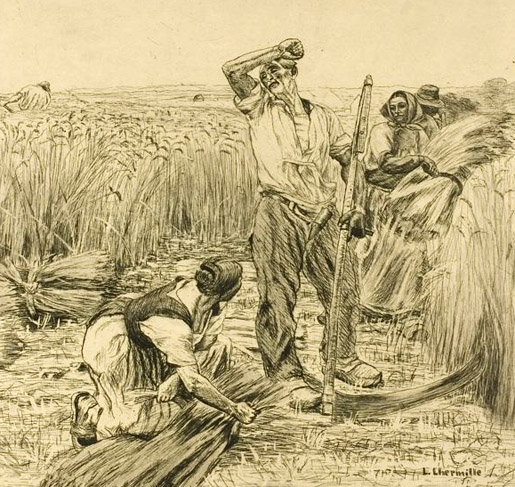 |
La paye des moissonneurs, 1882, par Léon-Augustin Lhermitte (1844-1925)
|
06 - 12/02//2024 |
 |
USA: What Could Go Right? How US Elections Work?
US elections have become more secure over time, not less.
See
theprogressnetwork.orgv
How to power the future (Nature)
Researchers are developing new kinds of batteries that could provide cheaper,
more efficient ways to power electric vehicles — and perhaps even aeroplanes.
One of the biggest challenges will be finding a battery design using a
resource that’s cheaper and more sustainable than the lithium most current
batteries are based on.
“All of the different chemistries that aren’t commercialized today have
their pros and cons,” says chemical engineer Brian Cunningham. “Our job
is to remove all those cons.”
See nature.com
The New American Energy Landscape
Few policy areas are more impactful than energy, which enables all economic
activity.
Unfortunately, the energy policy landscape has become a staging ground
for climate alarmists and degrowth ideologues seeking to enforce scarcity
on the rest of us.
In this episode of The Human Progress Podcast, Travis Fisher, the director
of energy and environmental policy studies at the Cato Institute, joins
Chelsea Follett to discuss recent developments in U.S. energy policy and
how they could impact our future.
See
humanprogress.org
A la fontaine, ca 1914, , par Léon-Augustin Lhermitte (1844-1925)
|
07 - 12/02//2024 |
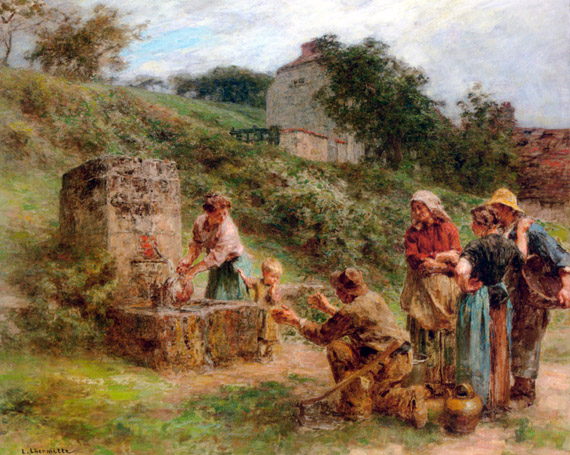 |
A Water Drawer, par Léon-Augustin Lhermitte (1844-1925)
|
08 - 12/02//2024 |
 |
Bad Joke? (Reader Digest)
|
12/02/2024
|
 |
India’s Good Fortune
Over the last two decades, India has more than halved its poverty rate,
expanded electricity nationwide, and set itself up for a future of energy
abundance.
See
humanprogress.org
Formula One Innovates the Speed of Surgery
A London hospital reduced the time to perform various surgical procedures
by 75 to 95 percent. Its inspiration? Formula One pit stops.
See
humanprogress.org
Time Pricing Mark Perry’s Chart of the Century
Mark Perry, an economics professor at the University of Michigan, regularly
publishes a chart illustrating changes in the nominal prices of US consumer
goods and services since 2000.
Converting his data into time prices—the length of time the average American
has to work to earn the money to buy something—reveals a clearer, more
optimistic view of how our living standards have changed.
See
humanprogress.org
Two-thirds of adult cancers largely ‘down to bad luck’ rather than
genes
It may be sheer good fortune that some people exposed to cancer-causing
agents do not develop the disease, study suggests
See
theguardian.com
A wave of new medicines known as biologics will be good for drugmakers,
but may not be so good for health budgets
See
economist.com
Breton Peasants Buying Fruit at Landerneau, par Léon-Augustin Lhermitte
(1844-1925)
|
09 - 12/02//2024 |
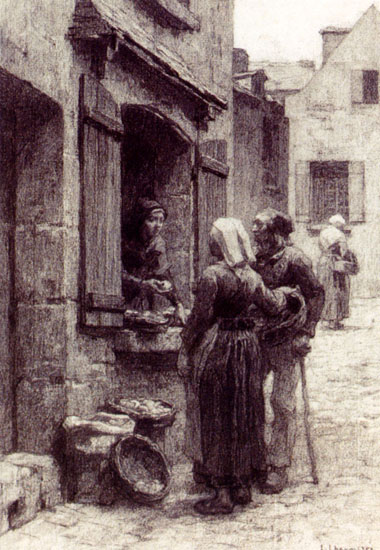 |
La lecture, par Léon-Augustin Lhermitte (1844-1925)
|
10 - 12/02//2024 |
 |
El campo europeo exhibe su fuerza, de Marc Bassets, 04 feb 2024
De los Países Bajos a Polonia, pasando por Alemania y Francia, la cólera
de los agricultores recorre Europa y arranca concesiones a los gobernantes.
El poder les teme. La mayoría de sus conciudadanos mira a los agricultores
con una mezcla de distancia y respeto. Son pocos en la Unión Europea (UE),
unos nueve millones, un 2% de la población, y generan un 1,4% del PIB
del club comunitario. Pero poseen una influencia que otros movimientos
sociales y sectores de la economía y la sociedad ni sueñan con tener.
Y la utilizan.
De los Países Bajos a Rumania, de Francia a Polonia, un actor ha tomado
la escena: el tractor, icono de un campo europeo que se moviliza y asusta
al poder. “Quizá esto sea un punto de inflexión”, dice Dominique Moïsi,
consejero especial del laboratorio de ideas Instituto Montaigne y observador
de los corrientes de fondo que agitan a Europa y el mundo. “Tengo la impresión
de que los agricultores se sienten irresistibles, que sus demandas son
justas y que están en posición de fuerza para exigirlas.”
.../...
Ver
elpais.com
Die kleine Kräutersammlerin, von Anton Heinrich Dieffenbach (DE, 1831-1914)
|
11 - 12/02//2024 |
 |
Die kleinen Reisigsammlerinnen (1872), von Franz von Defregger (Austrian,
1835 – 1921)
|
12 - 12/02//2024 |
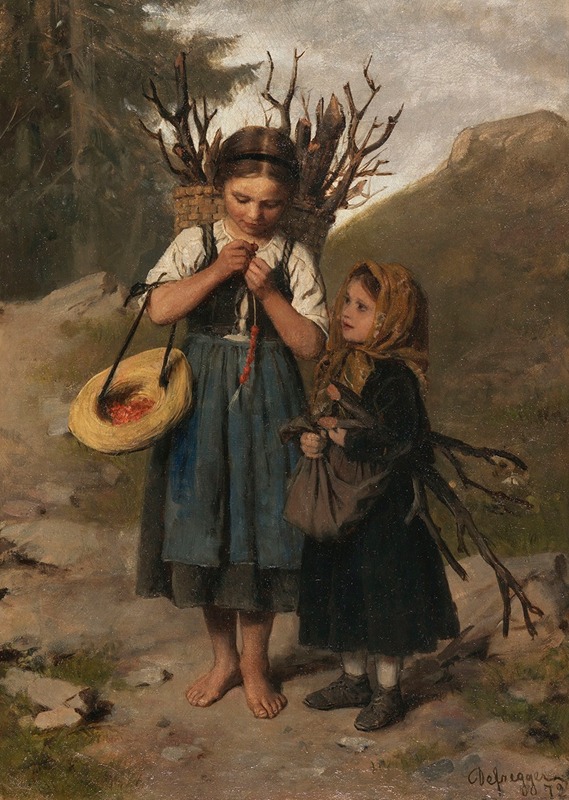 |
Barcelona, laboratorio de la sequía en el sur de Europa, de Clara Blanchar,
04 feb 2024
La ciudad y su área metropolitana, con tres millones de habitantes, tienen
un consumo razonable de agua y grandes acuíferos, pero necesitarán infraestructuras
de desalinización y regeneración para abastecerse en el futuro
Barcelona es la primera gran ciudad del sur de Europa que se enfrenta
a una situación de sequía extrema y a las restricciones de agua que comportan.
La ciudad tiene 1,6 millones de habitantes; tres millones si se suman
los 35 municipios colindantes que forman el Área Metropolitana de Barcelona
(AMB). En los últimos años ha habido episodios de sequía severa y restricciones
en otras zonas del continente, como Francia e Italia, pero han afectado
a poblaciones más pequeñas que la conurbación barcelonesa. Aquí, la emergencia
por sequía impide regar parques con agua de boca y las actuaciones serán
de mínimos, con agua del subsuelo, no potable, que se trasladará con cubas.
Además, se han cerrado un 25% de las duchas de los centros deportivos
y las fuentes ornamentales están secas. Si no llueve, en julio las restricciones
llegarán a las casas, donde se reducirá la presión del agua. A corto plazo
el Gobierno se plantea llevar barcos con agua desde Valencia.
> Cataluña entra en emergencia ante la peor sequía jamás registrada
Pero la capital catalana y su área no tienen una mala situación de partida
y han hecho deberes. El consumo de agua es razonable: 170 litros por persona
y día de media, un cómputo que incluye el gasto doméstico, pero también
el de los servicios públicos, industria o agricultura. Además, Barcelona
tiene fuentes de agua alternativas a los embalses, como grandes acuíferos,
y ha invertido en sistemas pioneros de aprovechamiento del agua de lluvia,
con depósitos, colectores y pavimentos drenantes. Con un con consumo doméstico
de 104 litros diarios por persona, la ciudad se abastece también de las
desalinizadoras construidas tras la gran sequía de 2008 y, en el último
año, el agua regenerada (la que sale de depuradoras, se trata, y se vierte
a ríos o acuíferos para luego captarla y potabilizarla). Pero con el cambio
climático acelerándose y la perspectiva de sequías más severas, todo esto
junto no será suficiente.
La solución está en nuevas infraestructuras de producción y reciclaje
de agua: desalinizadoras, estaciones de regeneración de agua de depuradoras
y plantas potabilizadoras. Un remedio caro, con costes ambientales y cuestionado
por organizaciones que apuestan por un cambio estructural de modelo. Pero
que ha sido la receta para grandes conurbaciones urbanas afectadas por
sequías en otras partes del mundo. El país pionero es Israel, que comenzó
a construir infraestructuras en los años 70 del siglo pasado para producir
y reciclar agua. También California (Estados Unidos) y Singapur, en el
sudeste asiático, recurren a las desaladoras y a la regeneración. Y extremo
fue el caso de Ciudad del Cabo (Sudáfrica), que en 2018 estuvo a punto
de quedarse sin agua, hasta el punto de tener un plan de actuación para
lo que llamó el “Día Cero”.
>>> Solo la mitad de agua llega desde los embalses
En una situación normal, Barcelona y su área, que forman parte de la red
de los ríos Ter y Llobregat, se abastecían en un 80% con agua de los embalses.
Con la sequía, hoy los pantanos solo aportan la mitad del agua, y el resto
proviene del subsuelo, las dos desaladoras activas, 24 estaciones de regeneración
de agua (un sistema que apenas tiene un año de uso) y tres plantas potabilizadoras,
detalla la Agencia Catalana del Agua (ACA) de la Generalitat.
En 2022, el Área Metropolitana de Barcelona, el organismo competente en
materia de abastecimiento, aprobó con un Plan Estratégico del Ciclo Integral
(el PECIA) en vistas a 2050 que plantea construir nuevas infraestructuras
para garantizar la disponibilidad de agua. Proyecta una planta potabilizadora
y una estación de regeneración de agua en el río Besòs, uno de los dos
que flanquean la ciudad y donde en su día no se invirtió porque era una
cloaca al aire libre, hoy recuperado. El otro río de Barcelona es el Llobregat,
que ya tiene estas infraestructuras. El plan metropolitano sugiere también
una batería de medidas de ahorro, mejora de las instalaciones existentes
y renovación de la red.
>>>Déficit de agua y necesidad de producir agua
El documento del AMB señala que Barcelona y su entorno disponen de 803
hectómetros cúbicos de agua al año, mientras la demanda es de casi 400.
Pero avisa de que el cambio climático reducirá un 12% los recursos superficiales
y las cuencas internas de los ríos Ter y Llobregat, y un 9% los recursos
subterráneos, al tiempo que aumentará la demanda para usos agrícolas y
de población, por los planes urbanísticos pendientes. Sin las actuaciones
previstas, el documento señala que en 2050 el déficit de agua potable
sería de 11 hectómetros cúbicos, que podrían llegar a 43 hectómetros en
situación de sequía. Fuentes de la propia AMB admiten que “el panorama”
es peor que el descrito en el Plan, porque el cambio climático y la sequía
se han acelerado.
Sobre la construcción de nuevas infraestructuras para aprovechar agua
de mar o reciclar el agua de las depuradoras, a escala de toda Cataluña,
el consejero de Acción Climática de la Generalitat, David Mascort, celebró
en diciembre durante la COP28 celebrada en Dubai: “En cuatro años seremos
capaces de reutilizar el mismo volumen de agua que necesita Barcelona
para abastecerse durante un año”. Mascort recordó que Cataluña tiene 24
estaciones de regeneración de agua depurada, una cantidad que se quiere
doblar. Y una terceras desalinizadora proyectadas.
Desde la Universidad Politécnica de Cataluña, el catedrático de hidrogeología
de la escuela de Caminos, Xavier Sánchez Vila, sintetiza que “a futuro”
habrá que “incrementar el agua regenerada y tener las desaladoras para
las emergencias, como ahora, pero en paralelo plantear qué país queremos,
porque cualquier proyecto o actividad supone gastar agua, y todo tiene
costes y beneficios”. La campaña D’on no n’hi ha no en raja (se podría
traducir por algo parecido a De donde no hay, no se puede sacar) de entidades
sociales, del territorio y ecologistas, ha reclamado hace unos días un
cambio estructural en el modelo de gestión del agua. Denuncian “la opacidad
sobre los consumos, laxitud con los grandes consumidores de agua y graves
impactos sobre los ríos” y consideran negativo “continuar promoviendo
un modelo económico basado en el aumento del turismo y la exportación
de carne y fruta, que seca y contamina las masas de agua disponibles”.
>>> Una nueva ordenanza para aprovechar las aguas grises
En el Ayuntamiento de Barcelona, el director de proyectos de la empresa
municipal Barcelona Ciclo del Agua (BCASA), Alejandro Ortiz, detalla el
plan de sequía que contempla recursos hídricos alternativos a escala de
la ciudad. Utilizar más la gran bolsa del subsuelo, que no es potable
pero se usa para regar o la limpieza urbana, es uno de los principales
objetivos: por un lado conectarla con toda la ciudad y por otro regenerar
la del Besòs e incrementar los caudales río arriba. Pero la ciudad también
está construyendo una doble red en el nuevo barrio de La Marina, con agua
potable y agua regenerada para las cisternas de los baños y el riego.
Y está redactando una nueva ordenanza de aguas grises para reaprovechar
las aguas domésticas no fecales para llenar cisternas, una normativa que
se quiere aplicar en edificios de obra nueva o grandes rehabilitaciones.
Y otro proyecto en cartera es captar agua de mar para las fuentes ornamentales
o para las centrales de frío y calor.
En noviembre pasado, la red C40, que agrupa a un centenar de ciudades
contra el cambio climático, publicó una declaración titulada Water Save
Crisis, en vistas a situaciones de graves sequías o inundaciones, que
es un llamamiento para aumentar la resiliencia de las urbes y sobre todo
proteger a la población más vulnerable. “Sabemos que el cambio climático
incrementa los episodios extremos del clima, con sequías, inundaciones
y olas de calor, que están presentes en el 90% de los desastres globales”,
explica la directora en Europa de la red, Julia López. La declaración
propone establecer sistemas de alerta, planes de respuesta que garanticen
las necesidades básicas y el acceso al agua potable. E insta a las ciudades
a “colaborar con el sector privado y las organizaciones”.
Marc Montlleó biólogo y profesor en el master de Desarrollo Urbano y Territorial
de la UPC y en el programa Ciudad y Urbanismo de la UOC, que participó
en la redacción del plan estratégico, lamenta que “se invierte a golpe
de crisis”, pero que, al mismo tiempo, “hemos podido aguantar los últimos
tres años gracias a esas inversiones”. Alerta de que “la próxima sequía
será más pronto que tarde y más dura”. Y por último lanza una reflexión:
“Podemos ser más eficientes, aprovechar el freático, no perder ni gota,
hacer desaladoras... y con tiempo y dinero dar agua a la población. Pero
el problema, los grandes perjudicados del cambio climático son el medio
natural: la agricultura, la ganadería, los bosques, los acuíferos y los
ríos. En definitiva, los ecosistemas serán a la larga los grandes perjudicados
con la crisis climática”.
>>> Israel, Singapur, California o Ciudad del Cabo: territorios
y urbes que han afrontado grandes sequías
- Israel, donde cada gota se aprovecha dos veces. Con muy pocos recursos
hídricos sumados al cambio climático, Israel fue pionero en el uso de
desalinizadoras (la primera es de los años 70 del siglo pasado) y plantas
regeneradoras de agua. El 85% del agua desalinizada se usa para los hogares
y el 90% de la reutilizada se emplea en la agricultura. Los expertos lo
resumen así: “Cada gota de agua se utiliza dos veces”.
- Singapur importa agua. Singapur, en el sudeste asiático y con casi seis
millones de habitantes, también ha sufrido grandes sequías durante este
siglo (la última en 2019) y recorre a la importación (desde Malasia, con
un contrato hasta 2060), la desalinización, a regenerar agua usada (tiene
cinco plantas de regenerada para usos no humanos) y recoger las aguas
de las tormentas con embalses.
- California recurre a las desaladoras. California, otro punto de frecuentes
y severas sequías, ha recurrido sobre todo a las desalinizadoras para
combatirlas. Los futuros proyectos generan rechazo por su elevado coste
económico y ambiental (por el daño que provoca devolver la salmuera al
mar). También hay plantas regeneradoras y parte de esta agua se somete
a “reutilización potable indirecta”, al verterla en acuíferos de donde
se vuelve a extraer y tratar para distribuirla para consumo humano.
- El "día cero" que no llegó a Ciudad del Cabo. La sequía que
comenzó en 2015, sumada a fugas en la red, provocó una grave escasez de
agua en Ciudad del Cabo (Sudáfrica) en 2018. Pese a las advertencias sobre
el cambio climático, la falta de inversiones en plantas infraestructuras
alternativas a los embalses llevaron en 2018 a la ciudad a anunciar planes
para el Día Cero, cuando se quedaría sin agua. Las restricciones previas
a ese día, que finalmente no llegó, llevaron a reducir el consumo a un
tercio. Y se han impulsado inversiones para extraer agua de acuíferos
subterráneos.
Ver
elpais.com
Moarhäusl in der Nähe von Dölsach (Lienz), 1873, von Franz von Defregger
(Austrian, 1835 – 1921)
|
13 - 12/02//2024 |
An old woman at the hearth, 1922, by Valdemar Kornerup , Danish painter
(1865-1924)
|
14 - 12/02//2024 |
 |
Free Soviet speech
An American explains to a Russian that the United States is a truly free
country because he can stand in front of the White House and shout:
“To hell with Ronald Reagan!”.
The Russian says that this is nonsense because he can easily stand in
Red Square and shout:
“To hell with Ronald Reagan.”
See youngpioneertours.com
Percentage Change in Abundance Relative to Average Hourly Wages
|
01 - 12/02/2024 |
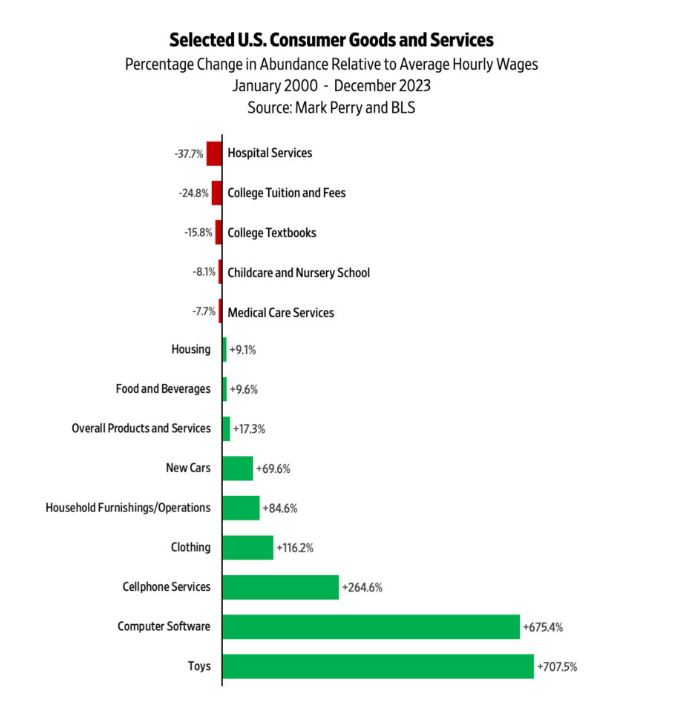 |
Prices changes from 2000 to 2023
|
02 - 12/02/2024 |
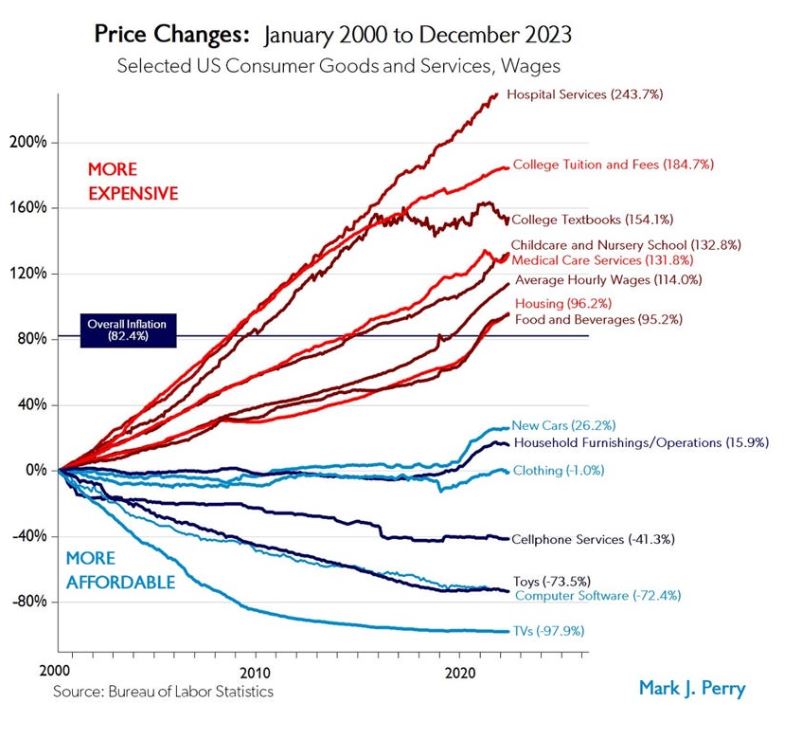 |
% of betting US population on American Football Matches
|
03 - 12/02/2024 |
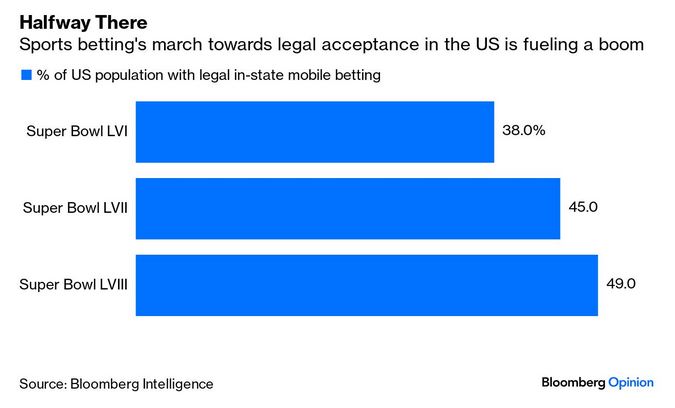 |
Election Day Equipment in the United Sates
|
04 - 12/02/2024 |
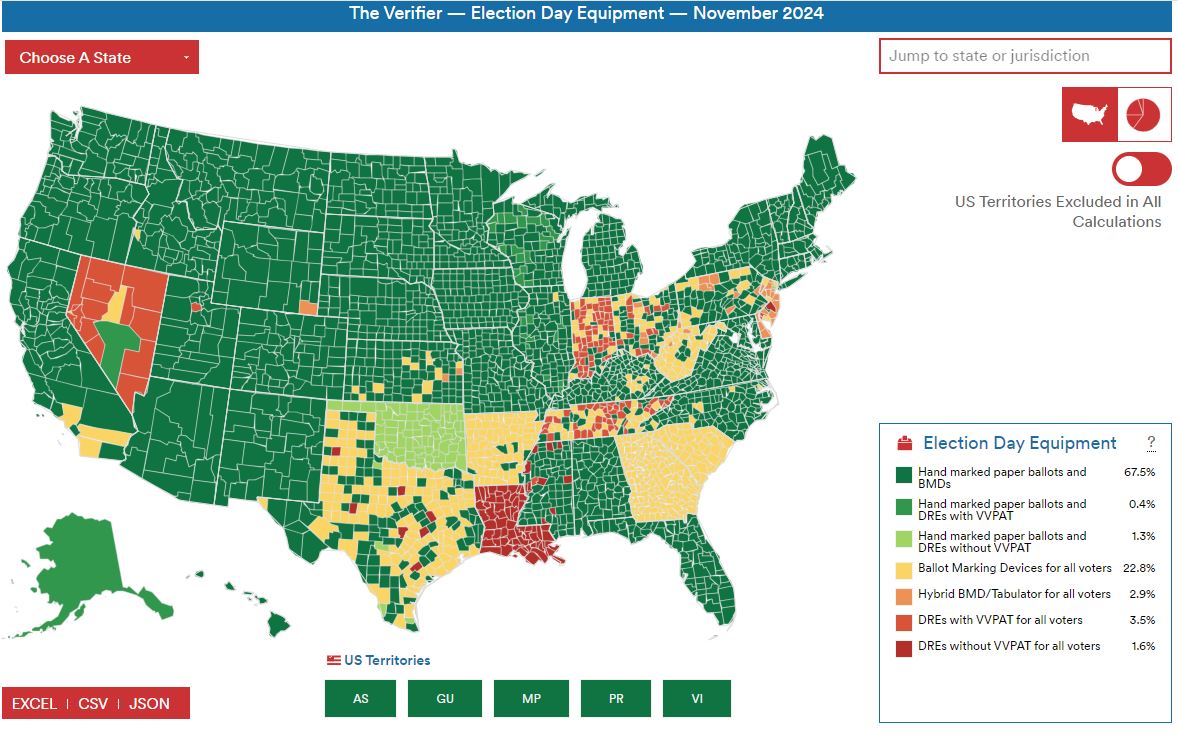 |
Luxury: LVMH First
|
05 - 12/02/2024 |
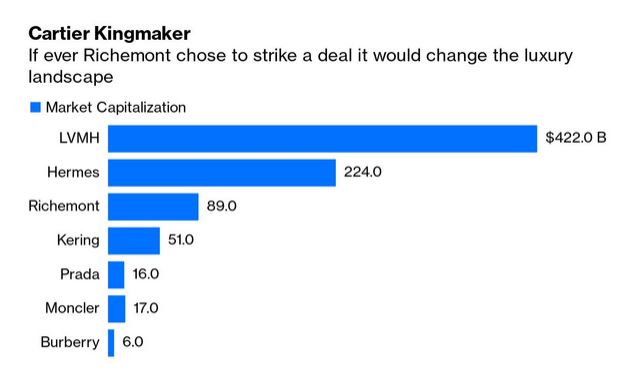 |
French Forest Carbon Balance
|
06 - 12/02/2024 |
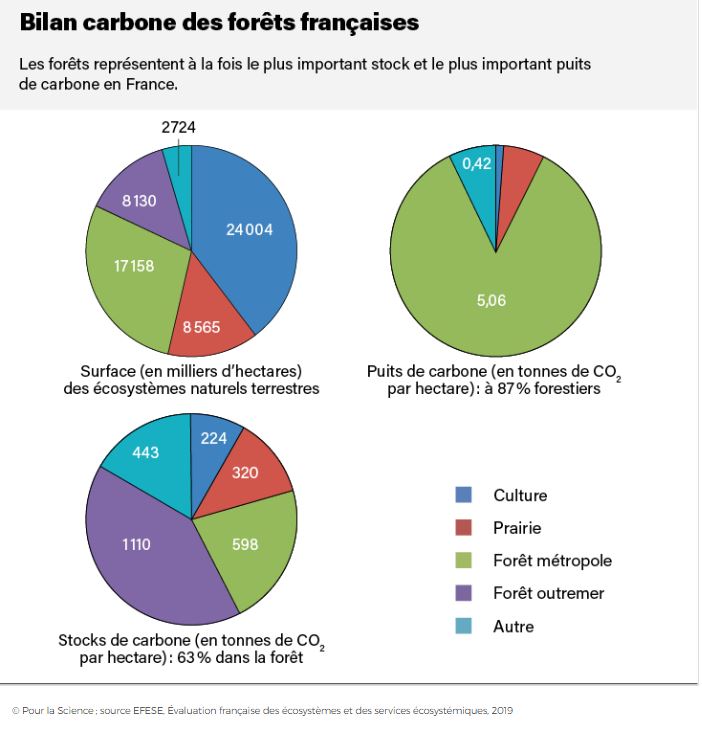 |
Chinese government bonds more profitable than US ones
|
07 - 12/02/2024 |
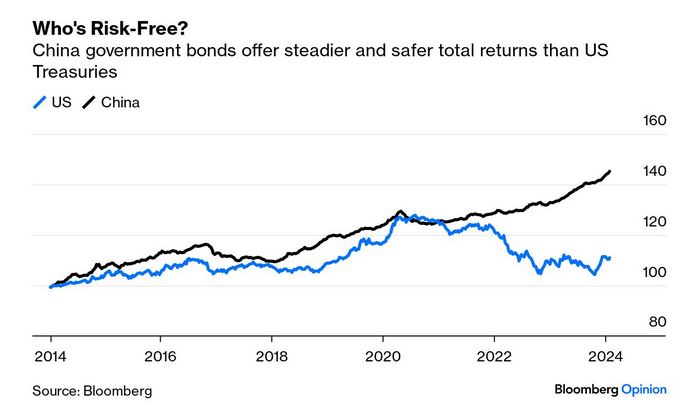 |
Biggest days at Wall Street
|
08 - 12/02/2024 |
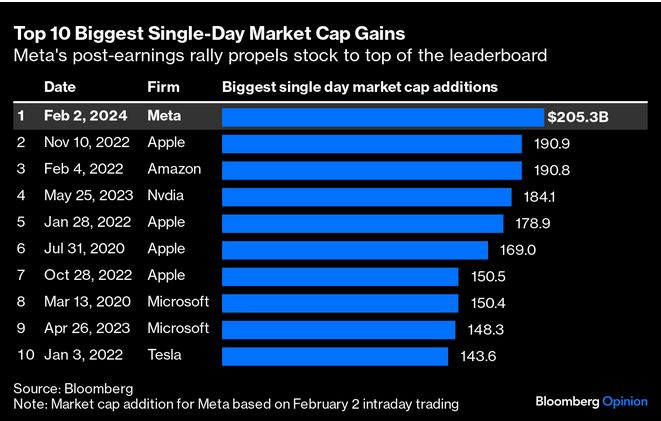 |
Low Workers' Confidence Level
|
09 - 12/02/2024 |
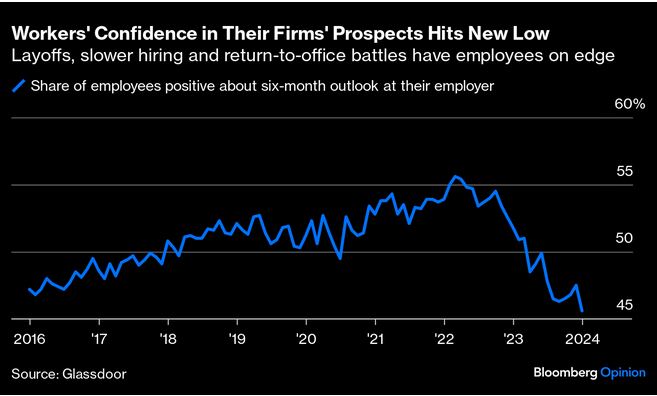 |
Underrepresented Hispanics and Blacks
|
10 - 12/02/2024 |
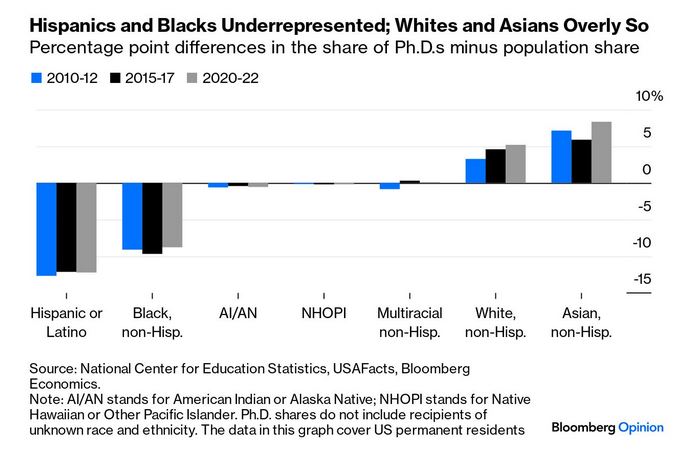 |
Used EV difficult to sell
|
11 - 12/02/2024 |
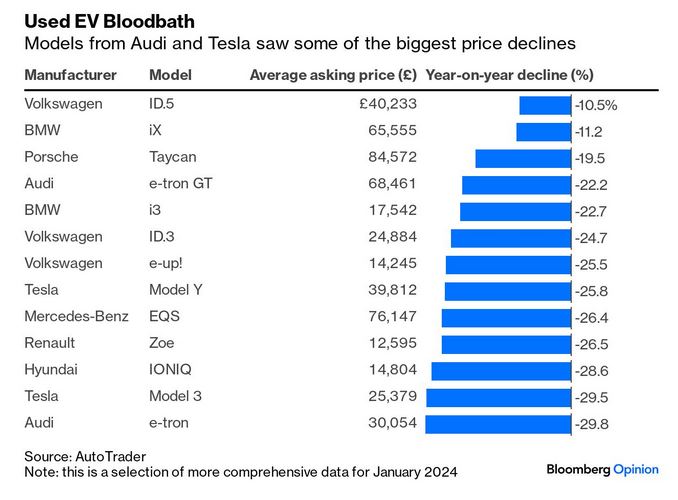 |
| |
The world has passed “peak child” (Our World In Data)
Hans Rosling famously coined the term “peak child” for the moment in global
demographic history when the number of children stops increasing.
According to UN data, the world has now passed “peak child,” which is
defined as the number of children under the age of five.
The chart shows the UN’s historical estimates and projections of the global
number of children under five.
It estimates that the number of under-fives in the world peaked in 2017.
Demographers expect a decades-long plateau before a more rapid decline
in the second half of the century.
The “ups and downs” in this chart reflect generational effects and “baby
booms” when there are large cohorts of women of reproductive age and high
fertility rates.
Explore our page on population...
|
01 - 12/02/2024 - See ourworldindata.org |
 |
About one quarter of CO2 emissions are covered by a carbon price (Our
World In Data)
People often compare the monetary price of fossil fuels to low-carbon
alternatives such as renewables or nuclear energy. But these comparisons
don’t capture the social and environmental costs of different fuels. The
true cost of burning fossil fuels is not reflected in their market price.
Burning fossil fuels drives climate change, which has very costly impacts
that we’re already seeing. Fossil fuels also cause local air pollution,
which kills millions every year and has negative health impacts for many
more.
One way to capture some of these external costs in the market is to put
a price on carbon. This makes fuels, products, and services that emit
more pollution more expensive. It also means it’s those who emit greenhouse
gasses that pay.
There are a few policies that countries can use, including a carbon tax
and an emissions trading system (sometimes called a “cap and trade” system).
Many countries have adopted such carbon pricing policies.
In this article, we provide an overview of which countries have carbon
prices, and how the price of carbon has changed over time.
|
02 - 12/02/2024 - See ourworldindata.org |
 |
It’s flu season: how many people die from the flu each year? (Our World
In Data)
|
03 - 12/02/2024 - See Our World In Data |
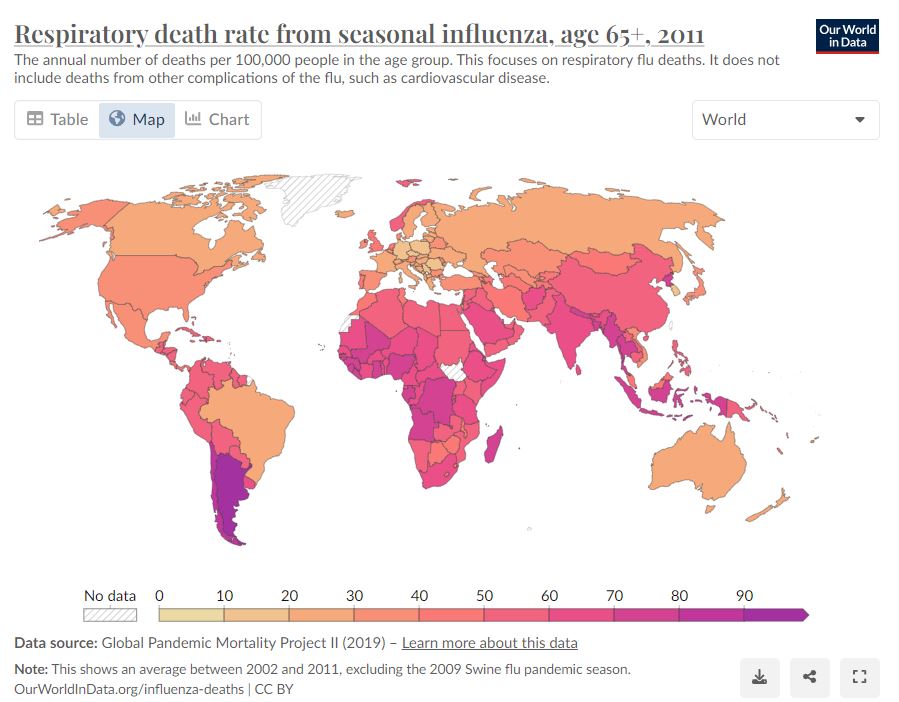 |
| |
The edition of this efita newsletter is sponsored by Acta Digital Services and its distribution by vitisphere.com
Please, contribute to the content of your efita newsletter, and advertise your events, new publications, new products and new project in this newsletter. Without your support, it will not survive!
Contact: Guy WAKSMAN
E-mail: guy.waksman(a)laposte.net
To read this newsletter on our web site
See Efita
The archives of this newsletter
See Efita
About the EFITA mailing list
You can use the efita moderated list (> 15000 subscribers) to announce any event / product / web site / joke (!) related to IT in agriculture, environment, food industry and rural areas.
If you want to subscribe a friend, please fill in his form.
If you do not wish to receive our messages, please fill in the following form...
